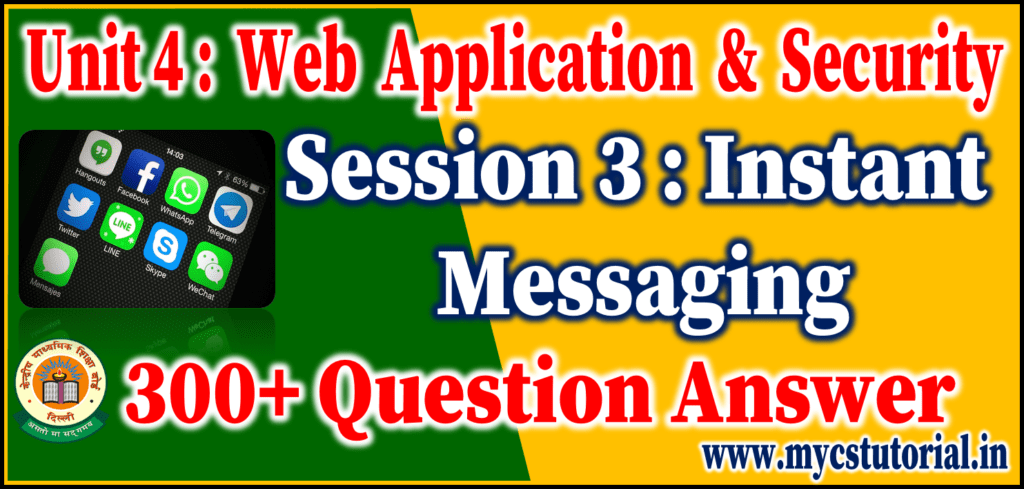GOOGLE TALK
Google Talk : Google Talk is an instant messaging service that provides both text and voice communication developed by Google Inc. Google Talk can also be used for making video calls.
Google Talk is free and is available as application based as well as web based. A Gmail account is required to use Google Talk.
Steps to Chat with a contact that is already added to your contact list.
a) Whenever your friend in the contact list is online you can see the person along with a green dot.
b) You can start sending text chat message instantly by double-clicking on a contact the other person will see the text message and respond to your message.
General rules and etiquettes to be followed while chatting :
1) Messages should be short and to the point.
2) Always introduce yourself by name if your screen name doesn’t reflect it.
3) Always ask if the other person has time to chat first.
4) Don’t Type your messages in uppercase as it seems to be extremely rude.
5) Give people time to respond.
CREATING AND PUBLISHING WEB PAGES – BLOG
Blog: A blog is a discussion style site used by non-technical (or technical users) users for creating personal web pages. Blogs are similar to an online personal diary and simple to use.
Some of the popular websites that offer blog service for free are:
www.wordpress.com
www.blogger.com
www.blog.com
www.weebly.com
www.blogsome.com
WordPress: WordPress is free web service that you can use to create a beautiful website or blog. WordPress has support for “themes” which can make the blog or the webpage look attractive.
How to create account in WordPress?
1) Open the Web Browser and type https://signup.WordPress.com/signup/.
2) Enter a unique address to your WordPress Blog. This is the address which others will use to view your blog.
3) Enter username and password to manage your blog.
4) Enter your Email Address and click on create blog.
5) An email will be sent (above mentioned email) for activating your blog account. Open your email and click on the activation link.
6) Now the blog is ready for use.
How to create post in WordPress?
1) Login to your WordPress Account.
2) To create a post, click New Post.
3) Type the title for your post.
4) Type the content which you want others to read. You can also add photos, videos, etc. to the blog using the options available in WordPress
5) Once you have finished typing the content, Click Publish Post to publish your content. This process is called posting content.
USING OFFLINE BLOG EDITORS
Offline Blog Editors:
Those Editors in which we can create blog when we do not have an active internet connection and publish the blog whenever internet connectivity is available are called Offline Blog Editors.
There are several free offline blog editors available such as :
Qumana
Windows Live Writer
Blogdesk
BlogJet
MarsEdit
Online transactions: Online transactions deals with transfer of money over the internet. There are many benefits of online transactions like, fast transaction speed, convenience, low risk of theft etc.
Some of the popular online transaction websites are:
1) IRCTC(Indian Railway Catering and Tourism Corporation), an online portal for booking flight and train tickets.
2) Flipkart, an online shopping portal for buying consumer products. Flipkart offers multiple payment methods like credit card, debit card, net banking, e-gift voucher, and Cash on Delivery.
3) EBay, an online portal for buying and selling goods.
4) Redbus, an online portal for booking bus tickets.
Online shopping: Online shopping is a form of electronic commerce where customers can buy or sell goods over the Internet.
Online shopping could be useful in situations when:
1) A customer does not have sufficient time to visit stores.
2) Visiting a store is more expensive than purchasing a product online.
3) A product or service that is not available in the local market is available online.
Internet security: Internet security is a branch of computer security specifically related to the Internet. Its objective is to establish rules and measures to use against attacks over the Internet.
Best Practices for Security:
1) Use strong password and keep on changing after every 2 -3 weeks.
2) Use encryption software to protect your data from unauthorized users.
3) Never save your username or password on shared computers.
4) Do not share personal information.
5) Use updated antivirus and antispyware software.
6) Clear browser cookies frequently.
7) Keep the operating system and software applications up to date.
8) Install Firewall : Firewalls analyse the network traffic and determine if the traffic should be allowed or not.
9) Never install software from unknown sources.
10) Remove unwanted or unknown software applications: These might have got installed without your knowledge when you have visited some websites.
11) Clear Data Stored In Browsers : It is not advisable to leave the web browser store data(username, password, credit card detail) particularly on public or shared computers.
General guidelines for managing strong passwords are:
- Keep the length of the password at least 12-14 characters if permitted.
- Avoid keeping passwords based on repetition, dictionary words, letter or number sequences, usernames, relative or pet names, etc.
- Including numbers, and symbols in passwords if allowed.
- Use capital and lower-case letters.
- Avoid using the same password for multiple sites or purposes.
- Avoid using something that the public or workmates know you strongly like or dislike.
NOTE :
www.strongpasswordgenerator.com help to generate strong password.
Examples of Online threats are Phishing, email spoofing, chat spoofing, etc.
A combination of alphanumeric and special characters could be used for creating a password that is not so easy to crack.
Programs such as keyloggers track and transmit every key that is pressed on a keyboard
(keystrokes) to unauthorized users
MAINTAIN WORKPLACE SAFETY
Every organization must follow a standard set of safety rules and procedures. These rules must be stated and displayed clearly in important areas. All the employees must be given demonstrations and training to follow safety rules.
Basic safety rules to follow at workplace – Fire safety, Falls and slips, Electrical safety, Use of first aid.
Timely repairs should be carried out by a competent person/ organization at the workplace/home to avoid/minimize any hazards.
Basic Fire safety rules in an organization are:
Most of the time fire can be prevented using appropriate measures.
Fire escape plans must be installed at proper levels
Conduct regular drills
Smoke alarms must be placed at proper intervals
Keep workplace a no-smoking zone
Maintenance of safety equipment must be taken care of regularly
Falls and Slips Safety rules:
Keep the moving area clean and clutter free.
Workplace must be proper ventilated receive light.
Wear non slippery footwear.
Floors must be clean and dry
Oil spills, dust must be immediately cleaned.
ELECTRICAL SAFETY RULES:
Following are some of the measures we should take to keep ourselves safe from electricity hazards and accidents:-
- Electrical equipment used should be approved by a recognised organization.
- Workers should be trained to handle the electric equipment safely
- Damaged and hazardous electrical equipment should be immediately replaced. All old and workout and frayed switches and wires should be changed.
- Heat emanating equipment should be kept away from the electrical equipment.
- Take care that the outlets/ circuits should not be overloaded.
- Switch off and unplug the electrical appliances before cleaning or relocating them.
USE OF FIRST AID
First Aid is the immediate assistance provided to the injured to save life and minimize health loss till the proper medical aid/ facility is provided.
Every organization must have basic First Aid Kit. Kit must have all necessary items. Make sure to check for the expiry of medical related items.
Some rules of First Aid are :
Assure the injured to remain calm and not to panic
Keep them warm if they are under shock
Do not move the victim in case of back/neck injury
Occupational hazard: An occupational hazard is the illness one may acquire due to his occupation.
Some types of occupational hazards are : Physical hazards, chemical hazards, biological hazards, behavioural hazards, radiological hazards, ergonomic hazards etc.
Accident: an accident is an unplanned event that may happen all of a sudden and may lead to unwanted or unprecedented results/outcomes.
Types of Accidents: Accidents may be of the following types :
Accidents at workplace : Slips and fall accidents, fire
Industrial disease/illness
Road traffic accidents
Clinical Accidents
Sports related accidents
Handling Accidents:
Accidents must be handled carefully. The accident should be handled compassionately without assigning blame on others.
Every organization must follow SOP for accident handling
Safety measures must be placed to prevent workplace accidents
Immediately call the medical team for any injury
Stay alert
Pay attention to and follow emergency drills
EMERGENCY: Any unexpected situation that needs immediate attention and action is called emergency.
An emergency situation is one that:
threatens the employees, customers or the public
disrupts or shuts down the operations
causes physical or environmental damage
TYPES OF EMERGENCY:
Various types of emergencies are there and there should be an emergency management plan to handle the situation of emergency.
Some of the types of emergencies are as follows :
Chemical spills
Extreme heat waves
Droughts
Pandemics
Terrorist attack
Fire
Floods
Thunderstorms
Leakage of some hazardous gas/ chemical
Some of the types of emergencies that require evacuation are:
Fire
Explosion
Floods
Earthquake
Hurricane
Tornado
Toxic material release
Civil disturbance
Workplace violence
HAZARDS AND SOURCES OF HAZARDS:
A hazard is anything that is the source of any potential harm, damage or any kind of potential loss of health or life.
The different types of hazards include:
Physical
Chemical
Biological
Mechanical
Evacuation:
Evacuation is the process of emptying a place in case of an emergency, disaster. Every company must ensure the following points for evacuation in case of any emergency:
An evacuation policy.
Organization must have a designated assembly point for emergencies.
Floor plans with evacuation routes pasted in work areas
Periodic evacuation drills should be conducted
Healthy Living:
A healthy living has a lasting impact on an individual which ultimately yields a healthy environment at home as well as at workplace.
A healthy lifestyle helps to keep and improve people’s health and well-being.
A healthy lifestyle includes :
healthy eating habits
physical activities
stress management
healthy mind
sound sleep
goal setting
By Anjeev Kr Singh – Computer Science Educator
Published on : May 23, 2022 | Updated on : May 23, 2022










